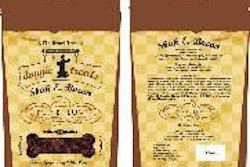.png?auto=format%2Ccompress&q=70&w=400)
Not so long ago, some hunters purchased old mules and horses, led them to a remote area, killed them, slashed their hides and left them for hound food. Flies, odors, putrefaction and sick dogs were common. Happily this practice was replaced with commercial petfoods. We've come a long way and the industry has much to be proud of.
Understanding our history inspires innovation and helps us avoid mistakes. What are the lessons from the commercial petfood industry's past, positive and negative? The answers are subjective, different people will learn different things. But are there some big lessons on which most of us would agree? Here are my nominees.
1. Milk-Bone as forefather
Today's global petfood industry descended from a product that came to be known as Milk-Bone. And in many ways, the evolution of Milk-Bone reflects the evolution of the petfood industry.
Perhaps inspired by the success of the first commercial dog food, Spratt's Dog Cakes, Milk-Bone was created in 1908 by the F. H. Bennett Biscuit Co. Originally named Maltoid, the biscuit was a bone-shaped dog food. The aim was to produce a biscuit with nourishing ingredients such as meat, cereals, milk, liver oil (to provide minerals), wheat germ and irradiated yeast (to provide vitamins). Milk-Bone was born as "Bennett's Milk-Bone Dog and Puppy Foods," packaged in individual boxes rather than in bulk (as was common then) to preserve its freshness, and various sized biscuits to meet the needs of different sized dogs.
2. Nabisco paves the way
In 1931 the F. H. Bennett Biscuit Co. was acquired by the National Biscuit Co. (now Nabisco), a company with its roots in making durable biscuits to sustain sailors on long journeys. Milk-Bone was the only Bennett product kept alive after the acquisition.
Nabisco was the fist national human food company to enter the petfood business. Thus, it behooved the company to overcome the apathy toward prepared dog foods. The missionary job was given to Nabisco's army of 3,000 salesmen who called upon the nation's grocery stores.
Up until then, petfoods were sold in feed stores and other independent retailers. The idea of stocking dog biscuits in grocery stores was an appalling one to grocers at first. But, through sheer persistence in selling, Nabisco laid the groundwork for distributing petfoods through retail grocery outlets. Since then some petfood companies have shunned distribution through grocery outlets and cultivated distribution through pet and feed stores. Most of these specialty channel companies went on to sell directly to pet superstores and some have gone back to the grocery.
In 1985, the tobacco company R.J. Reynolds purchased Nabisco, forming RJR Nabisco. Since then the Milk-Bone brand has had several owners.
- Kolberg Kravis Roberts bought RJR Nabisco in 1988 in the biggest leveraged buyout in history, described in the book Barbarians at the Gate: The Fall of RJR Nabisco.
- In 1989 Nabisco was sold to the French company Danone, a global producer of food products including Dannon and Perrier.
- In 2000 Philip Morris Cos. (now called the Altria Group) acquired Nabisco. Kraft Foods, at the time also a subsidiary of the Altria Group, eventually merged with Nabisco. In 2005, Kraft Foods and its Nabisco subsidiary were spun off from the Altria Group.
- Nabisco, under the ownership of Kraft Foods, sold the Milk-Bone rights to Del Monte Foods of San Francisco, California, in May 2006.
Milk-Bone shows that brand names can live on, regardless of ownership. Over the decades, the Milk-Bone marketing focus shifted from Milk-Bone being just a dog treat to a product that promoted cleaner teeth and better breath.
3. From horse meat to Quaker Oats
Meanwhile in 1922, the Chappel brothers of Rockford, Illinois, USA, introduced Ken-L Ration, the first canned dog food in the United States. It was horse meat. (Coincidentally, Rockford is also the corporate headquarters of Watt Publishing Co., parent of this magazine.)
Ken-L Ration became such a success that by the mid-1930s the Chappels were breeding horses just for dog food and slaughtering 50,000 of them a year. In 1942 Quaker Oats entered the petfood business through the purchase of Ken-L Ration (Chappel Brothers Packing Co.)
By 1941 canned dog food had a 90% share of the market, until the US entered World War II and the government started rationing tin and meat. Then dry dog food became popular again and the Chappel brothers switched to producing dry dog food.
4. Dog meal and Gaines-Burgers
The emergence of dog biscuits, kibble and canned horsemeat as basic categories of commercial petfood paved the way for a major new dry formula called dog meal. The pioneer was Clarence Gaines who in 1925 began heading up the Gaines Food Co.
Dog meal was originally sold in 100-pound bags but, by 1928, Gaines was also selling his customers empty 5- and 10-pound bags so they could divide the bulk into more manageable and less costly purchases.
Gaines sensed the need for sales promotion and utilized a now familiar dog show advertising theme by exhibiting his own pointers at field trials across the US where the superior quality of his entries nurtured interest and good will for Gaines Dog Meal. In a decade, Gaines had attained national distribution. In 1943, General Foods acquired the Gaines Food Co.
Gaines-Burgers was a brand of dog food introduced in 1961 by General Foods and produced through the 1990s. The product consisted of individually wrapped hamburger-like patties of soft-moist dog food that could be stored indefinitely at room temperature. At the time, soft-moist products were relatively new. The technology used to produce Gaines-Burgers was adapted and refined for human food products during the 1960s and 1970s.
5. Extrusion's big impact
In 1950 the Ralston Purina Co. started using a cooking extruder to make their Chex cereal. Ingredients were pushed through a tube, cooked under high pressure and puffed up with air. This allowed Chex to stay crisp in milk.
At about the same time, the company was getting complaints about the appearance, texture and digestibility of its dry dog food. Purina's petfood division borrowed an extruder from the cereal division and experimented with it for three years. The result: Purina Dog Chow was introduced in 1957 and in two years became the leading brand of dog food in the US. This expanded product had greater palatability due to its structure and fat coating. The exploded bulkiness of it resulted in much larger bags for the same weight as meal, a feature not overlooked at the supermarket level. Basic dry petfood processing hasn't changed much since, although a growing variety of alternative petfoods claim unique processing techniques.
Purina traces its roots to 1894, when founder William H. Danforth began producing feed for various farm animals under the name Purina Mills. In 1902, he merged with health guru Webster Edgerly, founder of Ralstonism, to form the Ralston-Purina Co. The letters for the word Ralston came from Regime, Activity, Light, Strength, Temperation, Oxygen and Nature.
6. It's about time: cat food
Cat foods were a minor factor in the early petfood industry. They were produced primarily along the coast where fish were readily available and were sold in 1-pound cans. Many labels were dubbed with the multiple title "dog and cat food" but little was known of the cat's nutritional requirements.
Smaller 6½ -ounce cans opened up a huge market, and soon cat foods were available in hundreds of varieties. Advertising began stressing that cats were also meat eaters as well as fish eaters, and petfood makers came up with ingredient combinations to woo the "finicky" cat. In 1982, Nestle launched Fancy Feast gourmet canned cat food in 3-ounce cans.
Petfood companies also found that cats, like dogs, would eat dry and soft-moist foods. Now cat foods are 40% of the dollar volume of the US petfood market.
7. Super sales of superpremium
In the mid 1970s, superpremium petfoods such as Hill's, Iams and Nutro began to make their mark. These companies contended that their products needed to be sold through pet and feed stores, veterinarians, breeders, groomers and kennels, somewhere a pet owner could be educated as to features and benefits. Hill's especially relied on veterinary recommendations to increase sales. All had breeder programs that led to breeders recommending their products to new puppy and kitten owners. This allowed for relatively low marketing costs and high profits.
8. Pet parents take over
Today, the petfood industry is dominated by large multinational companies such as Nestle, Mars, Proctor & Gamble, Colgate-Palmolive and Del Monte. They have fostered and continue to foster the emotion that pets are part of the family and that "pet parents" should give them the best.
Pet owners' desire to treat their pets especially well is leading to numerous niches, including ultrapremium, natural, raw, organic, grain free, human-quality ingredients and protein-focused diets. There are also niche products for skin health, gut health, dental health, urinary tract health, hairball prevention, pets with allergies and many more.
On the horizon, nutritional genomics will allow petfoods to be tailored to specific breeds and to an individual pet's genetic needs. New science and pet humanization will lead to even more new niches.
















